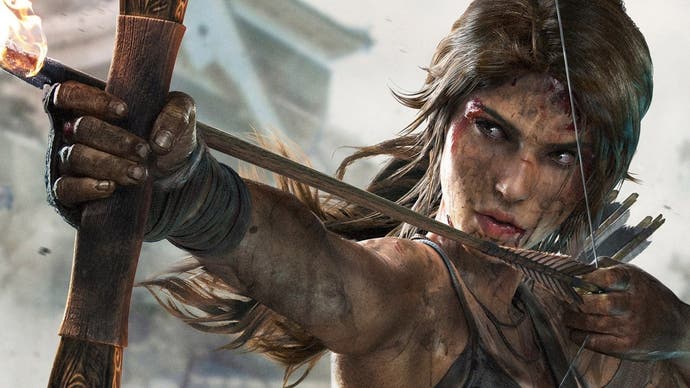Rhianna Pratchett's stories from the Tomb Raider reboot
"Lara doesn't need to follow in anyone's footsteps. She can be those footsteps for other people."
"There's definitely been a few significant female characters in the last decade, we've seen great things happening with Ellie from The Last of Us, and with the Horizon Zero Dawn franchise as well. We've seen a few more female protagonists coming out there, I think. But, [10 years ago] it was an unusual situation."
Rhianna Pratchett is talking to me about Tomb Raider, a game she wrote over a decade ago, to reboot the franchise. On 5th March, 2013, the world was reintroduced to Lara Croft, as she found herself washed up on the shores of Yamatai, a strange and storm-wracked island within the Dragon's Triangle. Unlike the Tomb Raider games that had come before, this version of Lara was young and inexperienced - she had not yet become the Tomb Raider synonymous with the series.
I talk to Pratchett over Zoom, with the idea that we'll take a quick look back at the game that ignited Tomb Raider's "Survivor" timeline. What I thought would be a half hour chat turns into something more, though: a brilliant, two-hour long dive into the games and Pratchett's relationship with them, covering everything from last minute story changes and a scrapped multiplayer experience, to the ways the games are shaped by her own memories and the importance of representation in media.
Rhianna Pratchett on her Tomb Raider audition

Pratchett takes me back to the very beginning - her audition for Tomb Raider. In my mind, an audition is for actors, not writers. However, Pratchett enlightens me, explaining during these "auditions" or "tests", developers often give writers a scenario to create (for example, a scene between two characters or diary entries to help build the world).
In Pratchett's Tomb Raider audition, she wrote "the bones" of the 'I don't think I'm that kind of Croft' scene. This is a moment in 2013's reboot where we really get to see how vulnerable Lara is, and how different she is to Lara in previous games. When her injured mentor, Roth, asks for her help, Lara doubts herself. Roth, however, believes in her. After all, she is a Croft. In reply, Lara admits she is not sure she is "that kind of Croft". Turns out, she is that sort of Croft, she just hasn't realised it yet.
"And it was like, I didn't know what this Croft [was going] to be," Pratchett laughs, thinking about the first time she wrote those words. "I wrote it not really knowing what Lara's character was going to be, or what the other Crofts were going to be. But I was just kind of playing around with something that spoke to a possible wider story."
After that, Pratchett had some follow-up interviews before landing the job, with her audition piece eventually evolving and making its way into the final release.
I tell Pratchett that line also made it into the 2018 Tomb Raider film adaptation. "I should get a commission!" she jokes.
Rhianna Pratchett on rebooting Lara Croft and Tomb Raider

Pratchett tells me she played a couple of the classic games, but she wasn't a "massive Tomb Raider fan" before working on the reboot.
"I'd seen the movies, of course. But I was actually put off as a younger female gamer by the way [Tomb Raider] was advertised," she admits. "It was all sort of like, nudge, nudge, wink, wink to the guy. And you know, she was very much marketed to the guys and that your girlfriend will be jealous and that sort of thing."
Pratchett says her younger self "just couldn't be doing with it" and so instead went off to play other things.
"And, I think I missed out because of this," she reflects. "I think it was the wrong way of marketing Lara. Many may disagree. But it was certainly the wrong way of marketing Lara to me. I think I missed out because of that marketing. And I don't think the games reflected that marketing."
Pratchett says rebooting the series was somewhat a blank slate for everyone involved. "Crystal [Dynamics, Tomb Raider's developer] had an idea of what [it] wanted to do, I had an idea of what I wanted to do, and it kind of naturally merged quite well."
As for the project itself, Pratchett says it didn't feel "too daunting" to take on. Rather it "felt right in terms of the trajectory of my career", with Pratchett noting she had worked on both Nariko in Heavenly Sword and Faith in Mirror's Edge before coming to Tomb Raider.
"It felt like working, in particular on female protagonists in interesting scenarios and worlds, was something I was quite familiar with doing," Pratchett reflects. "I thought, 'Yes, this feels right'. And, that really helped."
Pratchett was particularly drawn to the reboot after seeing its cover. "If you think about the art for the first game [in the reboot trilogy] where she's sort of holding her arm, she's got the bow, and she's kind of looking downward and pensive," Pratchett recalls. "I was like, 'Oh, this is really different' than when you think about the Lara covers of old."
Pratchett stresses "there is no shade towards classic Lara", but this reboot cover was just very different to what had gone before.
"It's a very characterful image, there's a lot going on, you know, the character is clearly thinking deeply about what's happening," Pratchett explains. "They've been hurt, they've got a weapon we're not so used to seeing Lara use, and that really drew me to it."
All of this meant that, when she got the chance to work on the series for herself, she was delighted at the opportunity.
"I mean, it's a real once in a career type of character to be handed," she smiles.
Rhianna Pratchett on Lara's character and the father/daughter relationship

While Pratchett certainly looks back fondly on her time working on Tomb Raider and its sequel, Rise of the Tomb Raider, she still has some grievances with how the story panned out. Most notably, those 'Father issues', and the push to write Lara as a "likeable" character - something she says is never as much a concern when it comes to writing male characters in games.
"Personally, from my taste, I would have rather given [Lara] a little bit more sass," Pratchett says.
"[Tomb Raider, 2013] was quite different tonally from the previous Tomb Raider games. And that was quite deliberate from Crystal - they didn't want her to have the kind of witty one liners because they felt that showed more confidence than she had at the time, which I completely, completely got.
"But I am someone that likes to find room for humour. And yeah, there are little bits of it... But you know, people deal with trauma and dark times in different ways. And by kind of making light [of it] or having a gallows humour around things like that, it can often be a way of dealing with it. So personally, I would have liked to have done a little bit more of that.
"I completely understood where Crystal was coming from. It was just my, my particular preference."
Pratchett has openly discussed her feelings about the father/daughter narrative that ran through the rebooted Tomb Raider games (in both the first two games of the reboot particularly, Lara feels under her father's shadow to a certain degree) in the past. She tells me this storyline was likely chosen because it felt "comfortable" for audiences.
Pratchett also notes the first Tomb Raider film starring Angelina Jolie also had a father/daughter relationship as a core part of its narrative, and this was also a theme in 2018's Alicia Vikander fronted adaptation.
"Father/offspring storylines are quite popular in games," Pratchett remarks. "Obviously, we've seen different permutations - Joel and Ellie, in The Last of Us, are probably most famous. And, you've got Kratos as well. There's quite a few of them, right?"
Pratchett says she would have liked to have seen her Tomb Raiders focus on the relationship between Lara and her mother, if there needed to be a parental focus at all. "I didn't really want to give her father issues," Pratchett says, stating it would have been great to have Lara's mother as "more of the archeologist" of the two.
However, and as Pratchett fully appreciates, at the end of the day "you have to do your job", and this was ultimately the direction Crystal wanted to go in. "You are part of a team... And other people have their own battles to fight and their own things that they want to achieve with their part of the game," she says. "You can't win every battle, and you certainly can't fight every battle. Otherwise, you'd run out of steam... It's very much a balancing act."
Instead of fighting this particular battle further, Pratchett found a way to connect with Lara and come to terms with the relationship with Richard Croft (Lara's father) by working stories of her own father into the series.
"I wove in some of [my father's] memories" into the scripts, Pratchett tells me. She says she penned letters from Richard to Lara where "he talks about the night that she was born and what happened", with Pratchett stating Lara's was "a difficult birth". This story is actually inspired by Pratchett's own birth, and her father's memories from that day.
Pratchett's father, fantasy author Terry Pratchett, specifically wrote down the story of his daughter's birth as it was a memory he did not want to forget. (Terry Pratchett was diagnosed with Alzheimers in 2007, and died of Alzheimer related complications in 2015.)
"I had been born, there was a snowstorm and he went home. He found a bit of stewing steak at the very bottom of the freezer and hammered it for about an hour until it was tender, and then cooked it with some onions and drank half a bottle of whiskey, and tried to make snowshoes out of tennis rackets, and then fell asleep in bed with a cat," Pratchett smiles, before revealing this story is "one of only a handful of times [she'd] ever either seen him cook or heard about him cooking things".Pratchett decided to use this story as inspiration for Lara's birth, and Richard's memories of it. "That kind of bonded me a little bit more to the storyline and gave me a little bit more," Pratchett states. "It felt a little bit more significant to me."
Rhianna Pratchett on Lara's sexuality and representation in games
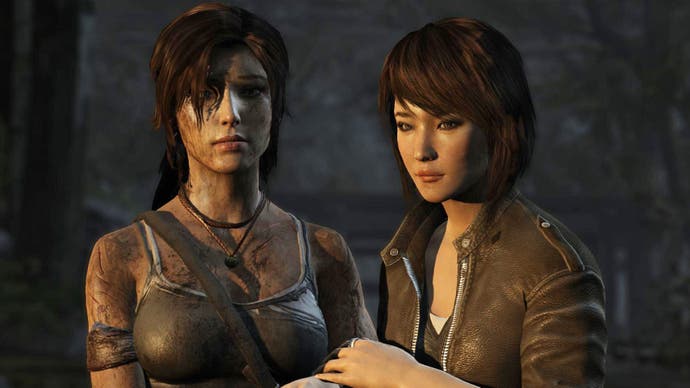
A pivotal relationship in Tomb Raider is the one between Lara and Sam Nishimura. Sam is Lara's best friend in the 2013 game, and part of the crew making the documentary about Yamatai. While it is never specified, soon after the game's release, many speculated that Lara and Sam were in fact a couple, given the lengths Lara goes to to save Sam, as well as their body language.
But, despite this discussion, Pratchett tells me Lara's sexuality wasn't something that Crystal and her particularly talked about during Tomb Raider's development.
"I don't think Crystal really wanted to explore that area of Lara and Sam in particular," Pratchett says. "I was very open to it as a writer. But, yeah, I think they didn't want to commit to it with the first game. I don't know why, perhaps they felt it would be too much of a distraction."
Pratchett adds: "I would have been perfectly happy to do it. I've got my own ideas... But I think Crystal...maybe [wanted to] leave that open to interpretation.
"I guess the short answer is, they didn't want to be explicit about it. They didn't want me to be explicit about it." Pratchett also states that, despite some previous narratives in the media, it was never a case of Crystal saying "no" to making Lara gay.
"There was a lot of discourse about it at the time because of one interview I did where I was speaking for a long time with the journalist about general representation and I said 'oh, I would have loved to have made Lara gay', as in like, if that had kind of come up and that was a direction that that Crystal wanted to take it, I would have been perfectly happy to," Pratchett recalls. "But it got changed as if I had come in with that particular agenda and Crystal had said 'no', and I was like, that wasn't the case at all, but it created a sort of narrative about it."
Even though Pratchett neither confirms nor denies Lara and Sam's relationship, she says seeing fanfic of the couple makes her feel "proud" to this day.
"I certainly know of one friend that realised she was gay from reading Lara and Sam fanfic and slashfic," Pratchett smiles. "I love seeing the fanfiction and the slash fiction that's out there."
Pratchett has now become "more mindful as a writer", noting how "important representation is to people".
"When I've more of a say in the creation of characters, I've been more mindful of that," she says. "I've introduced LGBTQ plus characters into my work since. So, I think [Tomb Raider] was great for that."
As for the future of Tomb Raider, Pratchett believes the franchise can stand to have a bit more representation within it.
"A good writer wants to take on subjects and sexuality and diversity in all its forms. Not just in sexual orientation, but in background and ability and age. They want to explore the paths not so well travelled, and there are a lot of paths not so well travelled in games," Pratchett says, before noting we are generally seeing better representation now than 10 years ago.
"I hope Crystal, or whoever works on the franchise, are going to be more diverse with representation in the future. I think the franchise can stand to have a bit of that. And I think it will go in that direction."
Pratchett is quick to clarify she doesn't know "any secrets or anything" about upcoming Tomb Raider projects, but states as "there are so many different arms of Tomb Raider in the works" she believes "we're going to see some interesting stuff" in the future.
Rhianna Pratchett on Tomb Raider's original, "much darker" ending

"Originally, Sam did not make it," Pratchett tells me. "[The ending] changed quite late in the day."
While Pratchett can't remember exactly how this Tomb Raider ending was initially conceived, she recalls the reaction to the draft where Sam died on Yamatai.
"We ended up actually having to put more other deaths in a scene, not because I particularly wanted them to be there, but gameplay would go: 'Okay, we want Lara to go here. And the motivation is gonna be this character, and this character is gonna die'," Pratchett explains.
"So I ended up having to do what I called 'death drafts' - I'd go back in, kill a character, take them out of all the scenes. And I did that a couple of times."
However, Pratchett says this meant the game ended up being a "cavalcade of death", something that made the "darkness of the ending [where Sam died] a lot darker and more depressing".
"Understandably, the playtesters felt it was a bit much... it was Walking Dead levels of depressing, which wasn't tonally how we imagined it," Pratchett laughs. "You realise how much gameplay decisions can affect the tone of the narrative. With all the death, it was just like, 'Oh, she just cannot catch a break'."
Pratchett is glad that Sam survived Tomb Raider's final cut, saying she feels the game is "stronger" for it. However, because this change happened "at the eleventh hour", it was a "scramble" to make it all work.
"I think we kind of managed it. But if we had done that a bit earlier, we could have finessed it a little bit more," she reflects. "I think it was good to have a bit more of a light at the ending, especially as you're losing several characters during [the game]. It would have been just nicer to have had more time to do it."
Rhianna Pratchett on Lara's first kill

Another change to Tomb Raider's final release are the events following Lara's first kill. While the kill itself remains the same - Lara shoots a man who is trying to assault her - Pratchett envisioned a much more impactful moment following this scene.
"She's obviously incredibly shaken, and she throws the gun away. She's kind of retching, and eventually picks [the gun] up and realises she's got to go on," Pratchett says. "And then we had environmental gameplay for a little bit, and then we had a scene with Roth."
This scene with Roth was originally intended to be a mocap scene, where Lara hears him "on the radio for the first time, or [it was] first time she's really got to speak to him". Pratchett says this scene would have shown Lara curling up into the foetal position around the radio as she tells Roth she had to kill someone.
"And he was like, 'that, that can't have been easy'... But Lara says, 'it's scary how easy it was'. And it was that moment where something breaks, where something breaks inside. You realise that you're capable of things you didn't think you were capable of."
Pratchett wanted this scene to be a moment of reflection for Lara and players. "Like, what does that mean? I thought I knew who I was, but who am I really? What am I capable of? And there was the emotional snap. And so, when we originally did those things, there was no killing in between the first kill and reflecting on what she'd done with Roth."
In the final release, however, Pratchett notes there are "something like 42 kills, put in between those two scenes", with the emotional mocap scene changed to gameplay of Lara climbing a ladder.
"It did mug some of the emotional heft of that [moment], and [the narrative team] saw it coming and we did say, 'Look, we're pushing the fact that she's just having more 'normal' human reactions to death and violence'."
Pratchett felt the Tomb Raider team was "selling [themselves] short" by having Lara immediately go out all guns blazing following her first kill. "It sort of mugs that character moment, and it certainly mugs the moment where [Lara says] 'I've killed people' - it was a less emotionally impactful thing."
This topic is something Pratchett has spoken about in length before, and she understands everyone's point of view. She appreciates that, generally when a player gets hold of a gun in a game, they assume gunplay will follow. As a result of this mentality, Pratchett says the narrative team "lost that battle".
"We knew we were going to get dinged for it... but I think it's a good learning experience. Because all these people, all these teams, are doing exactly the right [thing] with a mindset for their particular discipline, and what players want, and feedback, and things like that."
However, had Pratchett been in charge, she would have had Lara toss the gun "over a cliff" after her first kill, so it was no longer in her reach, let alone in her arsenal.
"Even though that'd be annoying to play as, you'd be like, 'Okay, I can understand why the character has done that'. And then [we'd give her] another situation where she's going to have to pick up a gun, but not in as violent a circumstance as she did the first time."
Pratchett feels this would have allowed a little bit of time for Lara's first kill to breathe.
"It is something I wish we had done differently," she says. "It's very hard... telling a story against that kind of [high octane, violent] gameplay. When you work in other mediums, we will say action equals character in film and TV. And the trouble is [in a game], you're not in charge of the action as a writer. That will either be down to the player, or whoever's dealing with the gameplay."
Pratchett says 10 years ago, a character's personal development in these situations wasn't as much a consideration to those in charge of directing gameplay. However, she feels there is now "more willingness to factor" it in.
"Action is part of what tells you about the character," she continues. "Narrative dissonance is the academic term for it. So, the story is saying one thing and gameplay is saying another. They can be really difficult to marry up. It's not an easy task."
To allow story and action to marry up, Pratchett says those involved need to "have that commitment at the start... to understand what you're getting players to say about a character, and what the story is saying about the character, and how to bring those together" to help keep everything "a little bit more aligned" on a game's final release.
Rhianna Pratchett on Tomb Raider's scrapped multiplayer idea
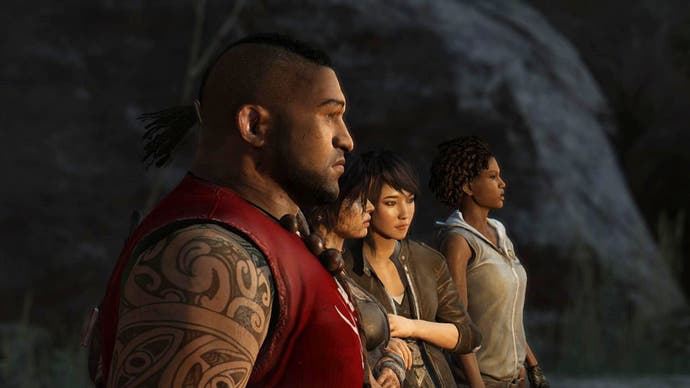
Tomb Raider's reboot had multiplayer, but there was once a different iteration of it in the pipeline.
"When I came on board, there were a load of characters because, at one point, the multiplayer was going to be a bit more story focused than it ended up being," Pratchett tells me.
"You were going to follow some of the other survivors on the Endurance in multiplayer and Lara in the singleplayer game... that was one of the early incarnations of it."
This meant the "other survivors would be having their own multiplayer experiences" on the ship while Lara's story played out on Yamatai. These two parts of the game would then "cross at various points".
Pratchett jokingly calls it a "sort of Walking Dead [singleplayer] against Left 4 Dead [multiplayer]" concept.
"It was a really cool idea actually," Pratchett says. "It just didn't, it just didn't work out. I don't know the ins and outs of it. But it didn't work out."
As a result of this scrapped idea, Prachett was left with a "cast of characters" that were once part of Tomb Raider's multiplayer story.
"So, that meant... we had to fold them into the singleplayer story. And you don't have a lot of space to do that," she tells me. "We had too many characters and not enough time to fully realise them."
She thinks it would have been "maybe better to have fewer characters" in the first game, and then introduce more in the sequel. "Or, just have more time."
Rhianna Pratchett on Jonah and the Tomb Raider comics
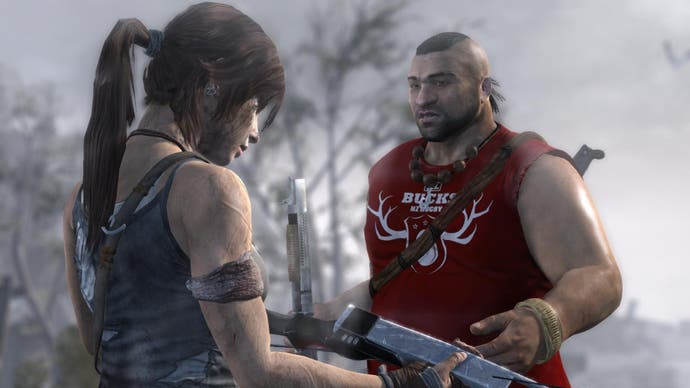
Jonah Maiava accompanies Lara on her adventures in all three games within the Tomb Raider reboot arc, but his inclusion in the sequels wasn't always a done deal.
"It was more of a last minute decision," Pratchett tells me. "It's really good to have seen him carried through, but that certainly wasn't the direction we knew we were going during the first game... There was a lot of back and forth at the start of like, which character was it going to be? Was it going to be Sam or Jonah, or maybe Reyes?"
Jonah may have ended up being the one that would join Lara on her adventures in both Rise and Shadow of the Tomb Raider, but that didn't mean other characters from the first game were sidelined for good. Thanks to the Tomb Raider comics, Pratchett was able to delve further into the first game's "secondary characters" as well, something she calls "cathartic".
In addition to Tomb Raider's established cast, Pratchett and the comic team were also able to introduce readers to characters such as Alex's "computer whizz" sister Kaz (the first confirmed gay character within the Tomb Raider series) and Grim's cats Tattie and Neeps. This is also where Lara's love of Jaffa Cakes comes in, something Pratchett initially included in the game before the script was tweaked.
"When I did the comics, I did focus more on the friendships and the human side of Lara, as much as the hero - I could get more fun things done in the comics. That was, I guess, a little bit more of a priority for me, to kind of bring back a little lightness to Lara and a little bit more humour. I'd say, tonally, the comics are a little bit more like classic Lara," Pratchett observes.
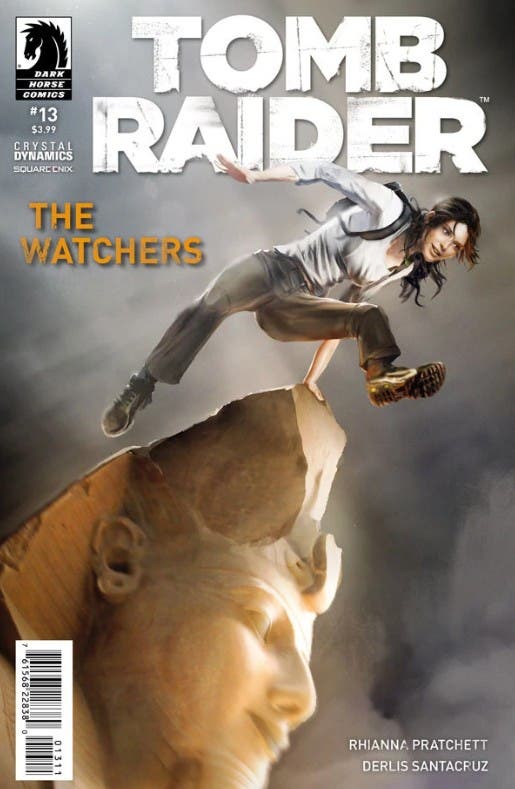
"[Lara] fights bad guys on the London Underground dressed as one of the Bennet sisters. And, like Sam, Sam attacks someone with a cupcake. Sam also punches a shark and yeah, there were a lot of fun scenarios that I came up with in the comics that were unfortunately never going to be in the games."
Pratchett's favourite comic book cover is Tomb Raider: The Watchers. The reason for this is simply because Lara is smiling. "It was just a really joyful picture. And that's one of my favourites because she looks so happy," Pratchett says. "And [Lara] didn't get a lot of that."
This particular comic opens with Lara running through the British Museum, after hours, and using exhibits "kind of as an assault course".
Pratchett actually went to the British Museum before writing this edition, so she could plan out Lara's route.
"So, okay, she's running past this one, she's gonna acknowledge that statue and then she can vault over this, and then she's gonna come down the stairs, and she's gonna land slap bang in the middle of this quote that's on the floor," Pratchett laughs, recalling her time in the museum. She then took photos of the exhibits for the comic's artist, and, as I have already said, the end result made this particular cover a Rhianna Pratchett favourite.
Rhianna Pratchett on reactions to the Tomb Raider reboot

"I think one of the misconceptions when we came out with the kind of 'New Adventures of Lara', was that we hated the classic version," Pratchett recalls.
"I think fans of the classic version would often pull apart interviews done with myself or other people and try to point to things that suggested that we hated the classic Lara, or, you know, we were disrespecting her. And, none of that was true."
Pratchett says there was a lot of fun with classic Lara, but essentially the team at Crystal wanted to "explore a different side of Lara, and a different time in her life".
"There was no disrespect for what had gone before."
Pratchett states, "this was just a reimagining, and a rewinding. We were doing our own take." Laughing, she adds: "You know, the classic games are great, the new games are great... they can coexist."
Rhianna Pratchett on learning curves and Rise of the Tomb Raider
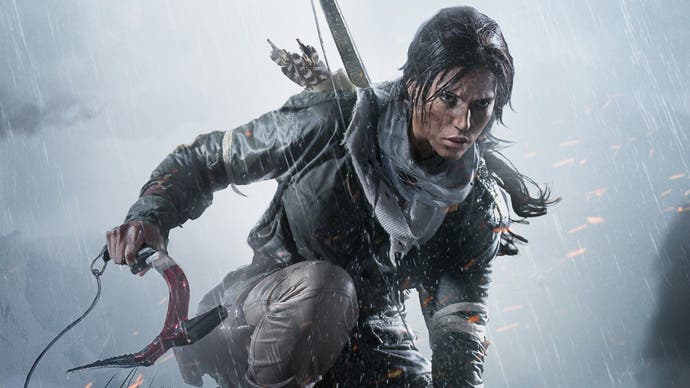
Changes made towards the end of the first game's development meant a few subsequent changes during the sequel's development.
"You learn so much going through the process, and when things go wrong... you learn more than when they go right really," Pratchett says. "Looking back at the first game, we can sort of see things like, 'Okay, we should have had more time to finesse that', and that meant the script for the second game got opened up to feedback very early on."
This, Pratchett tells me, felt "a bit uncomfortable", as the second script was "opened up in its early stages for feedback from a lot of people that [weren't] used to giving feedback on finished scripts, let alone scripts that are being developed."
Pratchett remembers "two years of continual feedback from the team, the publishers, from Microsoft, from external consultants".
"It felt like the narrative equivalent of open heart surgery... it was quite brutal from a writer's perspective."
For Pratchett, Rise of the Tomb Raider generally felt "harder" than the first. "I don't know if it's because the second game is nearer to the time I am talking about it now, but it felt harder because [we were] just having to satisfy so many people at the same time... where do I get my voice through," she says.
"So [Rise of the Tomb Raider] feels heavier in my brain. It wasn't like the first game was not hard. It was hard. But the second game was just, I guess, tougher in different ways."
However, this earlier feedback "allowed [the developers] to polish and finesse [the sequel] a little bit better," Pratchett says, telling me "I often think that the second game has more polish and the first game has more heart."
Rhianna Pratchett on Lara's PTSD in Rise of the Tomb Raider
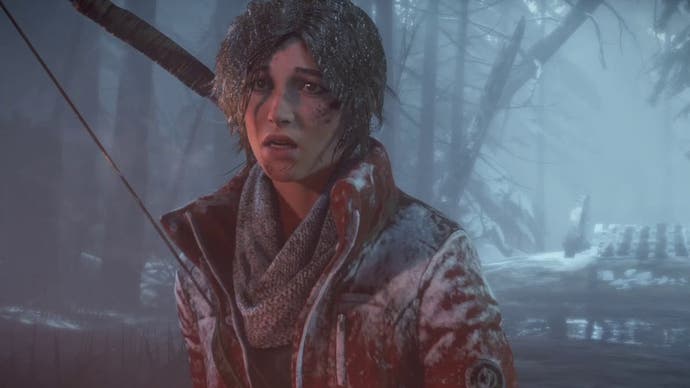
Pratchett, along with narrative designer John Stafford, initially wanted to explore Lara's PTSD more in the second game, and pitched "playable nightmares" to Crystal.
"I had the idea that she could have these scenarios from the first game that had got kind of twisted in her mind," Pratchett shares. "You'd be on the London Underground, or a street at night, and then something would happen that was kind of a merging in her head of real life and what she'd been through on the island. She was kind of reliving the traumatic experiences she'd been through against a new backdrop."
However, Crystal ultimately did not go for this idea, something Pratchett was disappointed about.
"I wanted to get into the guts of it," she states. "What would a human being that's been through this, what would their life be like afterwards? How do they go back to the real world and function after they've seen all this, after they've done all this? What they thought they knew about the world has been completely changed, because of what happened to them."
Pratchett said Lara was initially "a lot more chaotic" and "lost" in Rise of the Tomb Raider. "There is still some of that in the second game. But we were exploring that more on a gameplay level."
However, as those who have played will know, Crystal wanted Lara's story to go "down the more father route", with Pratchett joking: "As I've said, that wasn't my favourite."
Rhianna Pratchett on Shadow of the Tomb Raider
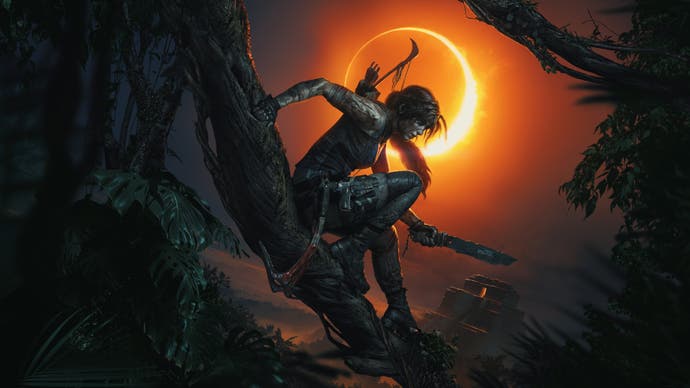
Despite Crystal Dynamics developing the first two games in the reboot series, development for Shadow of the Tomb Raider was handed over to Eidos Montreal. Had Crystal been working on Shadow of the Tomb Raider, however, Pratchett would have wanted to work on the final chapter.
"It would have been nice had Crystal been able to finish the trilogy [it] had started," she says. "I spent the best part of about six years with either Lara in the game or Lara in the comics. It would have been nice to have brought her to that conclusion."
Despite this, Pratchett doesn't know what her conclusion would have looked like, and says she hasn't played the third game. "In my head, I kind of finished the character at the end of Rise, and I have to sort of see it like that," she says.
Rhianna Pratchett on the the future of Tomb Raider
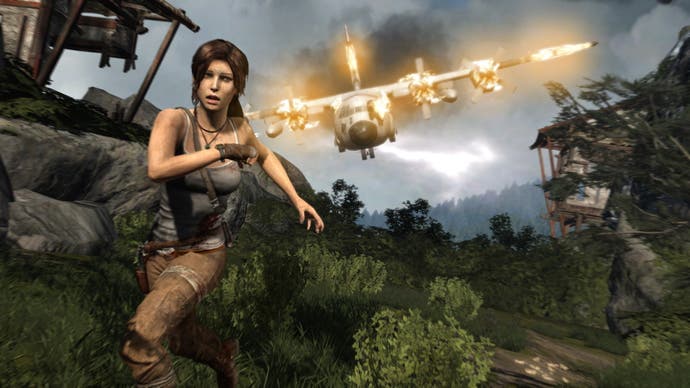
Pratchett hopes future iterations of Tomb Raider will allow Lara to embrace both the light and darkness of her personality.
"Let her have some fun, and humour, and relationships across the spectrum. Not just romantic or sexual, but friendship and everything in between," Pratchett implores. "Let her live as a human as well as a hero, and look at how those things conflict. That's where you get that interesting meet!
"When you are going back to the real world after you've just saved all your friends' lives multiple times, how does that change the nature of your friendships - how do they feel about you, how do you feel about them? I think that's really interesting."
Most importantly, Pratchett wants Lara to do things on "her own terms" and "forge her own path". Pratchett believes Lara now has enough experience under her belt to warrant that narrative.
"Lara doesn't need to follow in anyone's footsteps. She can be those footsteps for other people."
As for uniting the Tomb Raider timelines, Pratchett thinks the reboot has set Lara on the right path for this, noting that Lara is now a "little bit more like 'classic Lara' in attitude", especially in the comics.
"We've prepared the groundwork well," Pratchett smiles.
Rhianna Pratchett on looking back at Tomb Raider
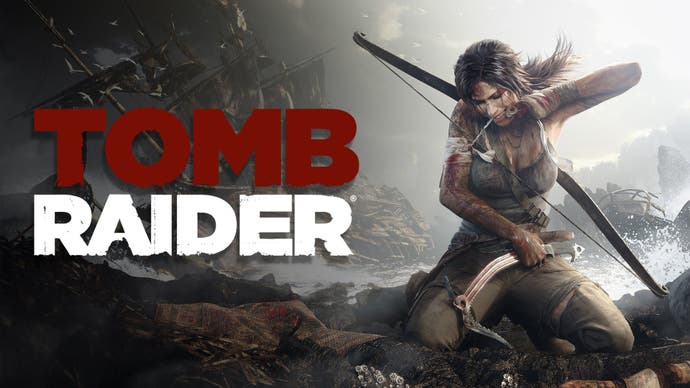
"It's nice to kind of go back with time and say 'okay, yeah, this came out well and this wasn't so good but we learned from it, and we did this differently... we can be more mindful of that," Pratchett says of her time with Tomb Raider.
"Whatever creative endeavour you do, it's not going to ever be 100 percent perfect, but it's actually in the bits that aren't perfect that you evolve more. That's what teaches you more, so being okay with things not going right and just exploring why it happened and how to take that learning experience on has really been great."
Pratchett closes: "I'm so honoured to have had that opportunity, to have worked on Lara - it really was the highlight of my game writing career, no doubt."
